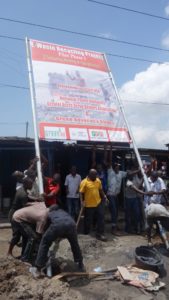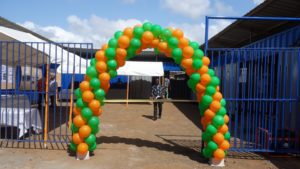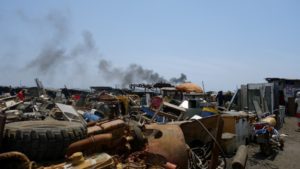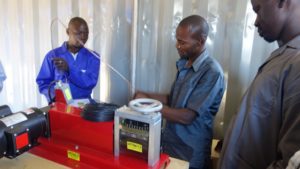UPDATE: June 2015
It has been eight months since Pure Earth opened the e-waste recycling center with automated wire-stripping units. We have been assessing what is working and what is not, as we enter the next phase of the project.
Lessons learned: While the automated wire strippers currently installed work well for larger cables, they cannot process the fine bundles of electrical cables, which continue to be burned. A shredding machine, called a granulator and separator, will be installed in the e-waste recycling center in July 2015. This machine chops up the wires, separates the metals from the plastic coating, and dispenses the materials in two separate streams. This allows for a higher yield of copper and additional revenue from the recycled plastics.
Our project team will be on site, working with partner organizations, Greater Accra Scrap Dealers Association and Green Advocacy Ghana, to install, test and train workers in the recycling center on this new technology.
The project remains on schedule and within budget. Pure Earth received funds from EC/UNIDO, Comic Relief, The Addax & Oryx Foundation, and BI Reserve totaling USD $226,865 for this project. In additional to the purchase of equipment and the structures housing the recycling center, the budget covered detailed environmental and economic assessments and trainings, among other project costs. In total, USD $149,060 has been spent to date, and USD $77,805 remains to be spent.
The next phase of the project will be determined after research into the effectiveness of the recycling center, and input from the local recyclers and partner NGOs.

On October 9, 2014, Agbogbloshie, Ghana – the second largest e-waste processing area in West Africa – got something new.
The excitement grew when residents saw a group of about a dozen men carrying a towering sign through town before planting it in the ground and raising it up in a Herculean effort, with six men on each side pushing and pulling.
The 20-foot tall sign announced the launch of a pilot project – the opening of a new e-waste recycling facility that could transform the way recyclers work in Agbogbloshie.
“Everyone is talking about how this is just the beginning,” said Kira Traore, the program director for Africa for Pure Earth.
“I think we are seeing a real commitment to changing the e-waste recycling industry.”
The new e-waste facility is equipped with four automated machines that can strip or pull apart plastic coated cables and wires of various sizes scavenged from the e-waste dump to extract copper and other valuable materials within without burning.
Stripping e-waste can save lives by reducing the vast amount of toxic fumes that are released by burning, poisoning thousands and contaminating the community’s land, water and food.
With the opening of this new facility, recyclers all over Agbogbloshie now have a safer option.
“Burning e-waste was and still is, to many, the established way of working here. That is why we are grateful to see so much support from the recyclers and residents of Agbogbloshie for this new recycling facility,” said Yaw Amoyaw-Osei, Founder/Executive Director of GreenAd, one of Pure Earth’s partners on the project.
“There was a lot of distrust initially. We had to convince the recyclers that we did not want to take away their livelihoods. We just want to find a non-toxic way for them to do their jobs. This is the first step towards stopping the mass poisoning of Agbogbloshie residents.”

It is difficult to miss the new facility. Consisting of three low-cost shipping containers that are painted a bright and cheery blue, the recycling center stands out against the scorched and burnt landscape.
Bright balloons formed an archway that welcomed all into the new center for the grand opening.
There was drumming and dancing, and school children, who put on a play about the dangers of e-waste.

The team – Pure Earth and local partners Green Advocacy Ghana (GreenAd) and the Greater Accra Scrap Dealers Association (GASDA) – was there along with local VIPS and stakeholders, including the Deputy Minister of the Environment, the Director of the EPA, and representatives from the World Bank, UNDP, GIZ, GRATIS Institute, ProLink, the National Youth Authority, the Ministry of Energy, the national Ghana electric company, the Customs Department, and EcoBank.
The recycling facility went up in much the same way as the sign that announced its opening – it was a collaborative effort.
“It was amazing to see so many of our supporters and stakeholders coming together for the opening,” said Yaw.
“We are receiving offers to help us bring in more machines, install sanitation equipment like a washing station and bathroom facility for the workers, provide business training, additional funding, and other means of support that will help ensure the success of this recycling facility.”


Pure Earth and partners have been piloting various technologies to aid recyclers in replacing the burning process since 2008. Hand wire-stripping tools introduced in 2010 were met with a small-degree of success. With the new automated machines, the team has high hopes of starting a mini “revolution” in the way recyclers work.

“This time, the recyclers are asking more questions about the machines and are offering more feedback and insights about the way they work,” said Kira.
“They are open about their needs because they know that we rely on their expertise. And we are very open about this being a pilot project, that we are trying to figure out what works and what doesn’t.”
This pilot is a project of the Global Alliance of Health and Pollution
Support for the project comes from the European Commission and the United Nations Industrial Development Organization (UNIDO) through the Global Alliance for Health and Pollution (GAHP),with additional funding for scaling up the project from Addax and Oryx Foundation. The National Youth Authority donated use of the land for the recycling center, with additional support from theMinistry of Environment and Ghana’s EPA, Ghana Health Services, and the Comic Relief Fund.
##
Related:
- See more PHOTOS of the opening and Agbogbloshie
- Press release: Change and hope comes to Agbogbloshie, Oct 22, 2014
- Transforming Agbogbloshie: From Toxic E-Waste Dump Into Model Recycling Center (PHOTOS)
- Ghana’s Tech Dump:The Untold Story (Magnum Photos)
Watch:
- VIDEO: French TV report, includes interview with Pure Earth’s local partner about our e-waste recycling center project in Agbogbloshie
- VIDEO: What is e-waste and how do we deal with the problem? Bill Suk (National Institute of Environmental Health Sciences) explains all.
Learn more:
Agbogbloshie has been called a toxic threat. The burning of e-waste releases copious amounts of toxic fumes, which then spreads throughout the community. An estimated 40,000 to as many as 250,000 people are at risk.
“Everywhere you look you see pieces of circuit boards, televisions, refrigerators, irons, etc. The toxic chemicals released are spread throughout the area when it rains and of course spread to the homes each evening. What especially troubled me was the path of the toxic smoke that floats right into the food market. So whatever doesn’t get into your lungs can now settle onto the food supply of Accra.”
— Dr. Jack Caravanos. Read more of his first-hand account in Report from Ghana’s Agbogbloshie Wasteland.
On previous visits, the Pure Earth team has documented the vast amount of contamination. Samples taken around the perimeter of Agbogbloshie, found a presence of lead levels as high as 18,125 ppm in soil. The US EPA standard for lead in soil is 400 ppm. Another set of samples taken from five workers on the site found aluminum, copper, iron, and lead levels above ACGIH TLV guidelines. For instance, it was found that one volunteer had aluminum exposure levels of 17 mg/m3 compared with the ACGIH TLV guideline of 1.0 mg/m3 (read more).





